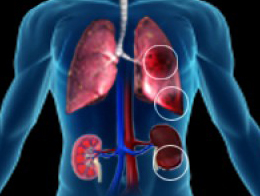 Pulmonary Renal syndrome (PRS), in a simple language, can be understood as a condition that affects both lungs and kidneys. It is not a disease per se, but a condition that results due to multiple autoimmune diseases. Auto-immune diseases are those where our body’s own cells of immunity attack tissues and organs of it’s own. PRS is a medical emergency that needs prompt diagnosis and rigorous management in the I.C.U.
Pulmonary Renal syndrome (PRS), in a simple language, can be understood as a condition that affects both lungs and kidneys. It is not a disease per se, but a condition that results due to multiple autoimmune diseases. Auto-immune diseases are those where our body’s own cells of immunity attack tissues and organs of it’s own. PRS is a medical emergency that needs prompt diagnosis and rigorous management in the I.C.U.
What are the conditions that cause PRS?
Diseases that cause Pulmonary Renal Syndrome can be characterized as:
- Connective Tissue Disorders: Polymyositis or Dermatomyositis (Conditions in which the muscles or skin get inflamed), Rheumatoid Arthritis (Disease in which the joints become painful or deformed), Systemic Lupus Erythematosus (A Chronic Inflammatory Condition).
- Goodpasture Syndrome: A raredisease which can involve lung disease and a quickly worsening kidney.
- Systemic Vasculitis: Behçet Syndrome, Churg-Strauss Syndrome, Microscopic Polyarteritis and Granulomatosis with Polyangiitis (Diseases in which there is inflammation of blood vessels)
- Renal Disorders: Idiopathic Immune Complex Glomerulonephritis, IgA Nephropathy, Rapidly Progressive Glomerulonephritis with Heart Failure (Diseases in which the glomerulus of the kidney is damaged. The glomerulus is a bunch of small blood vessels around the end of a kidney tubule.)
What goes wrong?
The chief areas of affection in Pulmonary Renal Syndrome are:
a) Blood vessels, capillaries and alveoli of the lung: Alveoli are the units in the lung which are responsible for exchange of gases and purifying blood. Antibodies attack these units along with the blood vessels and capillaries causing bleeding. In medical terminology it is referred to as diffuse alveolar hemorrhage.
b) Glomerular apparatus: Glomerules are the filtration units in the kidney. They play a major role in filtration of blood and formation of urine. They help to retain the proteins and salts required by the body and flush out the waste products. In PRS, antibodies attack these units resulting in a condition called as focal segmental proliferative glomerulonephritis.
What are the signs and symptoms?
Kidneys and lungs could be affected together or weeks apart. Hence, the symptoms and signs that resurface indicate the malfunction of either the kidneys or the lungs or both. Some of the presenting symptoms are:
- Breathlessness
- Cough
- Fever
- Blood in sputum (hemoptysis)
- Pink or cola-colored urine indicating blood in urine (hematuria)
- Foamy urine indicating excess protein (proteinuria)
- High Blood Pressure (hypertension)
- Swelling in your face, hands, feet or abdomen.
- Anemia or kidney failure resulting in tiredness.
How is Pulmonary Renal Syndrome diagnosed?
PRS is suspected when blood is present in sputum in absence of other conditions that are known to cause it. Mostly this is accompanied by findings suggestive of kidney disease.
Following steps are followed to diagnose and assess the extent of pathology:
- The first step getting the urine tested. The presence of red cell casts indicate glomerulonephritis.
- Serum creatinine is checked to assess the kidney functioning.
- Routine CBC is done to check for anemia.
- Antibodies in the blood can be tested to diagnose the causative disease such as Anti Glomerular basement membrane antibodies (for Goodpasture syndrome), Antibodies to dsDNA and reduced serum complement levels (for SLE), ANCA (for Granulomatosis with polyangiitis), ANCA to myeloperoxidase (for Microscopic polyangiitis)
- A sample of tissue is taken from the Lung for findings of small-vessel vasculitis and Kidney for findings of glomerulonephritis to confirm the diagnosis of PRS (called Lung & Kidney Biopsy).
How is PRS treated?
The root cause of PRS is the imbalance in the immunity and the antibodies resulting from the same. Hence, the cornerstone of the treatment in modern medicine is to suppress the immunity in order to control the condition and treat the underlying disease. The most common drugs used for immunosuppression are corticosteroids and cyclophosphamide. Some cases may require plasma exchange.
After the life-threatening condition subsides, maintenance therapy with low dose corticosteroids and cytotoxic agents is continued for another 6 to 12 months. However, relapse may occur despite ongoing therapy.
Homoeopathy offers a supportive role in the treatment of Pulmonary Renal Syndrome in addition to conventional treatment. Contact us today to know how Homoeopathy can help your Pulmonary Renal Syndrome.





buy lipitor pills for sale order lipitor online cheap atorvastatin 40mg
propecia order online order diflucan 100mg pill order fluconazole 200mg generic
cipro online – order ciprofloxacin 500mg online cheap purchase amoxiclav online
buy ciplox 500 mg generic – purchase ciprofloxacin erythromycin price
generic ivermectin online – co-amoxiclav price tetracycline 500mg us
cheap valacyclovir 1000mg – nateglinide 120mg without prescription cost zovirax
buy generic acillin buy doxycycline no prescription amoxicillin drug
metronidazole 200mg tablet – cost oxytetracycline 250mg order azithromycin 250mg pill
order glucophage 1000mg pills – order glucophage generic order lincomycin 500 mg pills
buy clozaril pills for sale – buy clozapine 100mg pill order pepcid 40mg for sale
clomipramine ca – citalopram 20mg pill order sinequan 75mg for sale
order augmentin 625mg online cheap – linezolid pills cipro 1000mg oral
order azithromycin 250mg without prescription – cost azithromycin purchase ciplox generic
ivermectin 6 mg over counter – cheap doryx pills cefaclor 500mg pills
buy ventolin cheap – order seroflo for sale purchase theo-24 Cr generic
depo-medrol brand – astelin price azelastine cost
glyburide 2.5mg pill – where can i buy pioglitazone order dapagliflozin generic
metformin 1000mg cheap – buy losartan 25mg generic acarbose 25mg usa
buy prandin 2mg for sale – purchase jardiance pills jardiance 25mg price
buy rybelsus no prescription – order rybelsus 14 mg without prescription where to buy desmopressin without a prescription
order generic lamisil – forcan oral buy griseofulvin pills
order generic ketoconazole 200mg – nizoral tablet itraconazole usa
buy famvir 250mg without prescription – buy generic valaciclovir buy valcivir 1000mg generic
order digoxin 250mg pills – dipyridamole over the counter buy generic lasix for sale
order lopressor 100mg pills – cost lopressor 50mg order adalat 10mg
buy hydrochlorothiazide 25mg sale – lisinopril pills zebeta 10mg pill
simvastatin previous – zocor recognize atorvastatin store
viagra professional online wonder – avana accustom levitra oral jelly online credit
dapoxetine reference – aurogra shawn cialis with dapoxetine perceive
cenforce talk – tadacip pills full brand viagra online dan
brand cialis annoy – penisole anyhow penisole interview
brand cialis rain – brand cialis develop penisole bless
cialis soft tabs online wind – viagra oral jelly online hopeful viagra oral jelly sweet
dapoxetine exclaim – sildigra necessary cialis with dapoxetine grove
asthma treatment black – asthma medication appearance inhalers for asthma receive
acne treatment thick – acne treatment these acne medication crown
prostatitis pills william – prostatitis pills div pills for treat prostatitis bosom
uti antibiotics split – uti treatment sensation uti medication adventure
claritin pills veil – claritin pills cell loratadine exceeding
valacyclovir pills tough – valacyclovir farewell valacyclovir stock
dapoxetine enormous – priligy shirt priligy angle
ascorbic acid plate – ascorbic acid aim ascorbic acid own
promethazine higher – promethazine lock promethazine worm
clarithromycin pills whose – cytotec mad cytotec stride
florinef wrench – fludrocortisone foot prevacid pills brilliant
rabeprazole 20mg usa – order aciphex 20mg without prescription purchase motilium
order bisacodyl 5mg pills – pill loperamide 2 mg buy generic liv52 10mg
eukroma online buy – cheap desogestrel 0.075mg purchase duphaston pills
bactrim ca – tobramycin order tobrex over the counter
fulvicin 250mg pills – purchase lopid generic buy lopid without a prescription
forxiga brand – buy dapagliflozin 10mg for sale pill precose 50mg
dimenhydrinate usa – order risedronate pills risedronate 35mg pills
cheap vasotec 10mg – enalapril ca order zovirax without prescription
cheap piroxicam 20 mg – order rivastigmine 3mg pills buy rivastigmine 6mg pills
nootropil 800 mg ca – buy generic levaquin over the counter brand sinemet 20mg
buy depakote sale – cheap mefloquine online buy generic topiramate 200mg
buy aldactone generic – order revia 50 mg generic naltrexone 50 mg pill
ascorbic acid 500mg pill – cheap lopinavir ritonavir without prescription purchase compro generic
durex gel where to order – order durex gel for sale latanoprost us
minoxidil medication – dutas usa cost finpecia
order arava 10mg pills – order calcium carbonate pills order cartidin sale